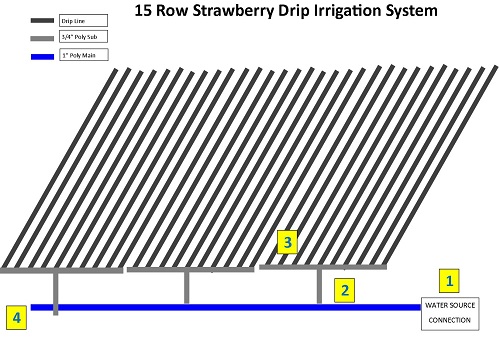
Irrigation Direct Canada
Unit 17- 5100 South Service Road, Burlington, Ontario, L7L 6A5, Canada
info@irrigationdirect.ca 905-631-9797
Monday - Thursday 9 AM - 3 PM
Fridays 9 AM - 2 PM
Strawberry Irrigation Zone and Drip Line Planning
| Strawberry Patch Irrigation Planning Your Strawberry Farm Drip Lines We will now use our water supply knowledge and apply it to a Drip Line layout. For this example we will assume a flow rate of 450 gph, and pressure of 50 PSI. Strawberries are commonly planted 18 to 24" apart with rows commonly 4 ft apart to allow for easy harvesting of the Strawberries. For our example we are planning a drip system with 30 rows each 100 ft long with Strawberries planted every 18". Step 1: Calculate Number of Emitters and Water Needed - In this example we will calculate the number of emitters as follows:
Step 2: Calculate Water Use Per Row and Choose Emitter Flow Rate - Choosing an emitter flow rate is one of the most critical components for planning an effective Drip Irrigation System. The decision will determine the number of rows you can water at one time while also impacting the time it takes to effectively water the entire Strawberry Patch. There are two factors to take into account when choosing an emitter. The two primary factor when choosing an emitter is water availability and time to water. The emitter flow rate can also be impacted by soil type. In this example we have 1,980 plants per area to water and have 450 gph available. As an example we will using an emitter flow rate of 1/2 gph to accomodate both drip emitters and self piercing emitters in the example. The total water requirement for the system to run will be 990 gallons per hour requiring a multiple zone sytem. If we are using drip emitter tubing we can re-evaluate our flow needs as drip emitter tubing emitters are offered as low as .26 gph which can enable you to water more than one zone at the same time depending on the spacing of emitters used within the tubing. Below is a table illustrating the maximum number of rows you can water at one time as well as the run time to give the Strawberries a 1/2 gallon of water.
**Maximum Number of Rows Calculated as 450 GPH ÷ Consumption (for 1/2 GPH Emitter) 33 GPH = 13.63 or approx. 13 As you can see as the Emitter output goes up the time to water goes down, and at the same time the number of rows that can be watered at any one time goes down. We have found most customers have chosen a lower emitter rate to increase the number of rows that can be watered at one time with 1/2 GPH being our most popular. For pressure compensated drip emitters the lowest available output is 1/2 GPH, however emitters available in Drip Emitter tubing are offered as low as .26 GPH. Step 3: Planning Your Zone Layout - When deciding on a zone layout for Drip Irrigation systems we always recommend to be conservative when planning your zone layout. Having more zones serves a few purposes; firstly it will ensure the zone has adaquate water supply to feed the emitters, and secondly provides more control over the entire system if for instance one zone has been harvested and needs to be shut off from the rest of the system. For this illustration we have 3 zones to accomodate our water restriction of 450 gph. Below is an illustration of the layout as well as a photo of the installation.
We will now look at the various connection options for installing your Strawberry irrigation system.
Ref 940 |
